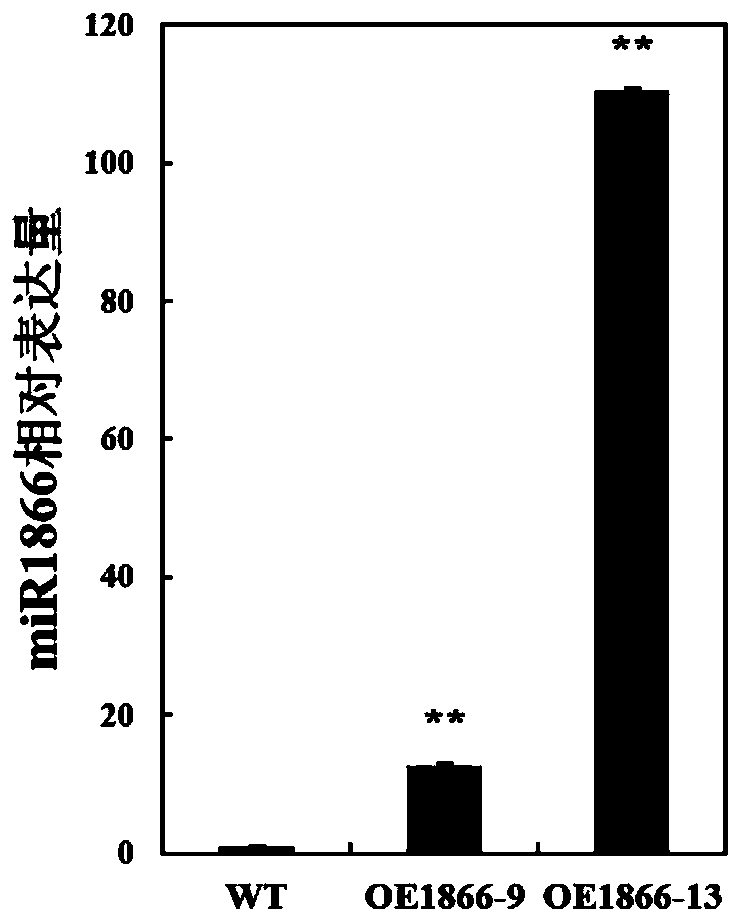MiR1866 gene for controlling rice seed germination, overexpression vector and preparation method thereof, gRNA expression vector, and application thereof
A technology of mir1866, pre-mir1866-r, applied in the directions of botanical equipment and methods, biochemical equipment and methods, DNA/RNA fragments, etc.
- Summary
- Abstract
- Description
- Claims
- Application Information
AI Technical Summary
Problems solved by technology
Method used
Image
Examples
Embodiment 1
[0042] The construction of the expression vector for mutating miR1866 gene comprises the following steps:
[0043] 1. Selection of gRNA target sequence of miR1866 gene and design of upstream and downstream primers of gRNA oligonucleotide chain
[0044] Design gRNA target sequence 5'-GGGATTTTGCGGGAATTTCA according to the sequence of rice miR1866 precursor (miRBase accession number MI0008267) CGG -3' (as shown in SEQ ID NO.22), the PAM sequence at the 3' end of the sequence is CGG, and the Cas9 protein will cut DNA at the 3-4bp upstream of the CGG sequence to form a smooth end. The target site and the PAM sequence are as follows figure 1 as shown, figure 1 It is a schematic diagram of sgRNA and Cas9 protein targeting miR1866 gene.
[0045] The mature body sequence of miR1866-5p is as follows:
[0046] GAGGGATTTTGCGGGAATTTCACG (shown in SEQ ID NO.1).
[0047] Design the upstream and downstream primers of the gRNA oligonucleotide chain according to the sgRNA sequence. The pr...
Embodiment 2
[0057] The application of the expression vector for mutating the miR1866 gene in the preparation of rice miR1866 gene mutants comprises the following steps:
[0058] 1. Agrobacterium-mediated genetic transformation of rice callus and detection of positive transgenic plants
[0059] Using the heat shock method, referring to the method reported by Hood et al. (Hood et al., 1993), the pH-Ubi-CAS9-miR1866 expression vector was introduced into Agrobacterium agrobacterium EHA105, and the rice variety Nipponbare was infected with Agrobacterium containing the CRISPR / Cas9-gRNA plasmid (Oryza sativa ssp. Japonica cv. Nipponbare) calli were transgenic in rice according to the method reported by Nishimura et al. (Nishimura et al., 2006), and regenerated shoots were obtained by screening with hygromycin. The genomic DNA of the transgenic plants was extracted by the SLS method, and positive screening of the transgenic plants was carried out using the vector universal primer U3-F and sgRNA-R...
Embodiment 3
[0070] The amplification of the miR1866 gene fragment comprises the following steps:
[0071]According to the sequence of the miR1866 gene (as shown in SEQ ID NO.3), the amplification primers Pre-miR1866-F and Pre-miR1866-R containing the miR1866 precursor sequence were designed (see Table 1 for the primer sequence), and according to the restriction site of the target vector pTCK303 point, add KpnI and BamHI restriction sites and protective bases at the 5′ ends of the forward and reverse primers, respectively. Using Nipponbare seedling DNA as a template, the miR1866 gene fragment was amplified, as follows:
[0072] aagc ggtaccGTACCAGGCCTC CTTTTGCACGGAGGGATTTTGCGGGAATTTCACGGGAATTGAGTTG ATTCCTGAAATTCCTGTAAAATTCTTGTGTTCCAAAGGA GCCCTggatcc actagtaata , where the lowercase underlined bases are the protective bases, the lowercase ununderlined bases are the restriction sites KpnI and BamHI, the uppercase underlined bases are the miR1866 precursor sequence, and the uppercase u...
PUM
 Login to View More
Login to View More Abstract
Description
Claims
Application Information
 Login to View More
Login to View More - R&D
- Intellectual Property
- Life Sciences
- Materials
- Tech Scout
- Unparalleled Data Quality
- Higher Quality Content
- 60% Fewer Hallucinations
Browse by: Latest US Patents, China's latest patents, Technical Efficacy Thesaurus, Application Domain, Technology Topic, Popular Technical Reports.
© 2025 PatSnap. All rights reserved.Legal|Privacy policy|Modern Slavery Act Transparency Statement|Sitemap|About US| Contact US: help@patsnap.com



